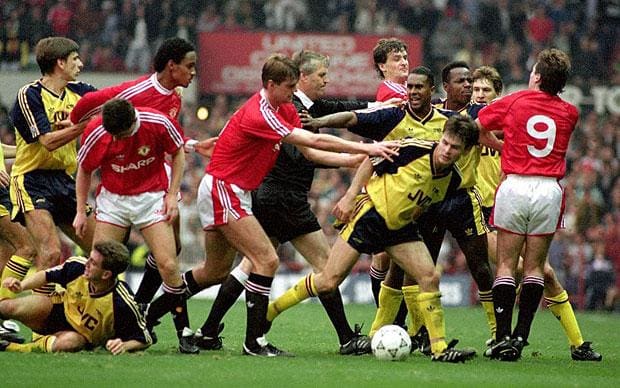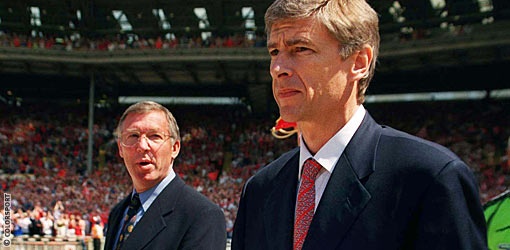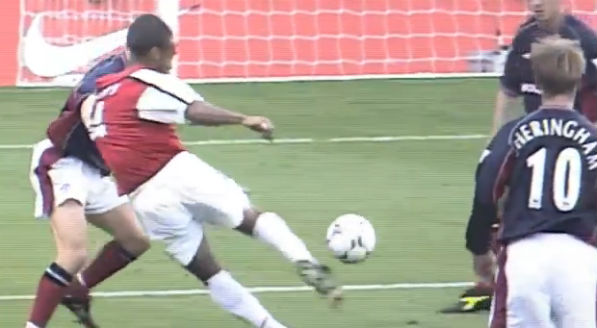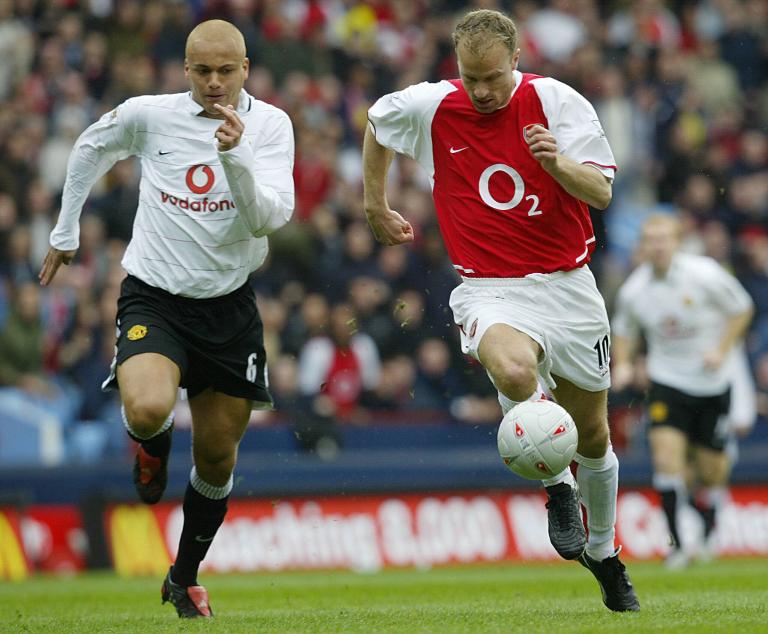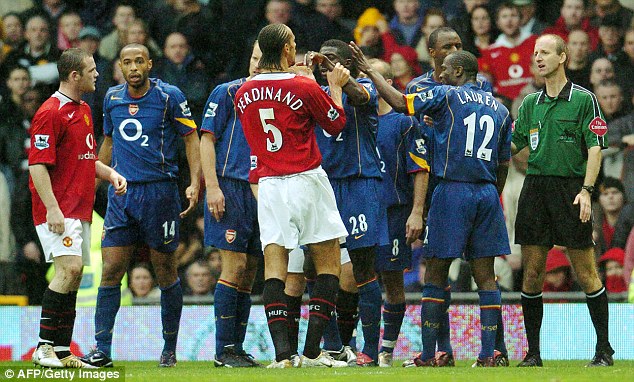Wenger vs Ferguson – a tribute to the greatest football rivalry of our time
- 1161 Views
- aksceditor
- September 6, 2016
- History
The clashes between them were akin to today’s El-Classico games
Until the late 2000s, Arsenal and Manchester United were not merely the main rivals, but arguably the only title rivals in the Premier League. The clashes between them were akin to today’s El-Classico games, as these two great clubs struggled for dominance, having already pushed aside the other 18 contenders in their way. With United completely lost without Sir Alex Ferguson and only qualifying once for the champions league since his departure and Arsenal still on the hunt for an EPL title in the last decade, other teams and rivalries have taken over the mantle of greatness once held by the two sides.
The early Premier League was, in many ways, a showdown between Arsenal and United. One of the two clubs won every Premier League until 2004, except for 1994 (when Blackburn pulled off a Leicester and shockingly won).
Denis Irwin and Brian McClair, began kicking Arsenal’s Nigel Winterburn
October 20th, 1990 is considered day zero of the rivalry. Although there were incidents before, including an FA Cup match the year before that saw a near fight, that October match was the match that lit the fire. Almost an hour into the game two United players, Denis Irwin and Brian McClair, began kicking Arsenal’s Nigel Winterburn as he lay on the ground. Soon all 22 players on the field were involved, creating a dangerous situation. Although the teams soon broke apart, it was a bad moment. The FA, shamed by the brawl and in the middle of dealing with rampant English hooliganism, took the unprecedented step of deducting both teams’ points, Arsenal two and United one (a most unfair decision). To this day it is the only time a club has been deducted points by the FA.
but the next season Arsenal got their revenge
The rivalry really heated up when Arsene Wenger took over Arsenal in the September of 1996. From the start, Wenger and Ferguson, then United’s manager for nearly a decade, were bitter enemies. After Wenger complained that the league schedule was manipulated to United’s advantage in late ‘97, Ferguson shot back, “Wenger doesn’t know anything about English football. He’s at a big club- well, Arsenal used to be a big club… He’s a novice and should keep to his opinions about Japanese football [where Wenger had coached for a year].” United won their second straight title that year, but the next season Arsenal got their revenge. Despite leading the league for the entire season, United collapsed after losing to Arsenal in mid March. Arsenal won their last 9 games to take the league back from Ferguson’s side, and after winning the FA Cup clinched their second club double, Wenger’s first.
The personal feud between Wenger and Ferguson continued to grow with both managers criticizing the other’s playing style.
Arsenal won the double in 97/98 and continued to challenge United against all odds.
The next few seasons however saw Arsenal finish runners up to United, and it was painfully obvious to Wenger that changes were needed.
Change was in part made easier by the aging out of many of Arsenal’s great 90s players. The backline that had held George Graham’s classic Arsenal side together, Nigel Winterburn, Lee Dixon, Steve Bould and the great Tony Adams, all retired at or just after the turn of the century. Wenger had the space and leverage, having been established at the club for a half a decade, to reshape the team in his own image. He brought Sol Campbell, Lauren and a young Ashley Cole in to fill the defense. Robert Pires and Gilberto joined earlier Wenger signings Patrick Viera and Fredie Ljungberg, along with academy graduate Ray Parlour, to create a high powered midfield. Meanwhile the attack was glorious.
Thierry Henry finished his transformation from a winger into a striker in time to unite with Bergkamp, creating one of the deadliest strike duos in Premier League history. Henry did the finishing, scoring over 30 goals for five straight seasons. But Bergkamp’s role as creator was just as crucial, with his dropping movements freeing space for Pires, Henry and the other midfielders to run into. He was also a playmaker, showing an incredible ability to put teammates through on goal with a single touch.
This new team reflected Wenger’s talent for repurposing players. Michael Cox describes it perfectly: “The most interesting thing about Arsenal’s defence is that none were defenders when Arsene Wenger first set eyes on them. Ashley Cole was a promising forward in the Arsenal youth system, Lauren was a central midfielder for Mallorca, whilst Kolo Toure was a versatile player who played most often in an advanced midfield position. But Wenger converted all of them to defenders, assuring Arsenal’s ball-playing ability was evident throughout the side.”
Driven by a diesel engine midfield
Indeed, the versatility of all the individuals in the side meant that Arsenal could adapt to the game. Their 4-4-2 formation suited the talents of the players perfectly. While capable of the fluid passing, possession based game that we all associate with Arsenal, the side could also play on the counter. Henry had originally been a winger, and retained a tendency to drift wide. Bergkamp also dropped off the front line and sometimes onto the wing, leaving tons of space for Ljungberg and Pires to cut inside from the wings. Driven by a diesel engine midfield, and with two fullbacks bombing down the wings, Arsenal on the counter was a force to be reckoned with.
With this injection of new life, Arsenal recaptured the Premier League in 01/02. Winning their last 13 games, including the title clincher at United on the penultimate weekend of the season, Arsenal scored in every match and failed to lose on the road. They finished 7 points above second place Liverpool. The previous weekend, Arsenal had beat Chelsea 2-0 to win the FA Cup. It was Wenger’s second double, and Arsenal’s third, an English record.
Arsenal, dominant and commanding, seemed to now be the leader in the rivalry; at one point in the season, United had sat in 9th place. Ferguson had planned on retiring, but announced that he would stay for three more seasons (it would be more, as we now know).
The 2002-03 season seemed like it would be the same as the season before: Arsenal would dominate, with United finishing somewhere behind them in second place. Indeed by the start of March the race looked over. United had failed to win a game in February, falling 8 points behind Arsenal. It was thought to be so certain that the title would return to Highbury and Wenger that Paddy Power and other betting services began paying out bets on Arsenal as Premier League champions.
Ferguson’s side relied on negative football
But suddenly Arsenal fell apart. A month later, United were just two points down, having amazingly revived their campaign. Then in mid-April United traveled to Arsenal for a mid week match, what many thought to be the title decider. Ruud Van Nistelrooy gave the Red Devils a first half lead, but Henry scored a brace early in the second half to give Arsenal the lead, and control of the title race back. But just seconds after Henry put Arsenal ahead, Ryan Giggs scored a header. With the game tied, and United up in the table (although Arsenal had a game in hand), Ferguson’s side relied on negative football and began to sit back. Finally, with just minutes left in the game, Sol Campbell threw an elbow at Ole Gunnar Solsjkaer as he ran by. Campbell saw red and Arsenal lost any hope of getting the win.
Now Arsenal needed to win all their remaining games, including a rescheduled match against Southampton, set for the last week of the season. But that game ended up never mattering. On the penultimate weekend Arsenal shockingly lost 3-2 at home to Leeds, giving United the title and keeping Leeds in the Premier League and out of bankruptcy. It would be Arsenal’s last loss for over a year and a half, almost 50 games.
It was a shocking collapse for Wenger and his team, made all the more bitter that United had pounced on their failures. Arsenal vowed never to meltdown as they had again.
Although Wenger could have panicked and brought in several new players, he didn’t
The summer of 2003 saw few new faces at Arsenal. Although Wenger could have panicked and brought in several new players, he didn’t, saying something about the trust he had in the players as well as the squad’s cohesion and ability. Jens Lehmann was brought in to replace the club legend, David Seaman, keeper at Arsenal for nearly a decade and a half. He was the last of the great 90s Arsenal defense to go, signaling the final stage of Arsenal’s transformation from George Graham’s team (a team that had dominated the late 80s and early 90s) to Wenger’s. Bergkamp was the only pre-Wenger starter, and he had only arrived in North London a year before Wenger had; anyway, Bergkamp had flourished under Wenger unlike anyone else in his career. Arsenal was completely Wenger’s.
There was one other signing that Wenger made that summer. A young midfielder out of La Masia, Barcelona’s academy, was signed to be Arsenal’s future playmaker. Cesc Fabregas arrived at Arsenal just in time to be part of the greatest English side ever.
United were making moves as well. This was the start, not the end, of a transition period for Fergie. David Beckham, after a year of disputes both public and private (including the infamous incident when Ferguson threw a shoe at the number 7), was sold to Real Madrid for £25 million (a tidy sum), joining (Brazilian) Ronaldo, Zidane, Luis Figo and Raul in the Galaticos project. Replacing him, for half the price, was a young, flashy 17 year old from Portugal: Crisitano Ronaldo.
An obscure Russian billionare
Ferguson also signed Tim Howard from the New York Metro Stars (a precursor to the Red Bulls) to replace Fabien Barthez in goal. United and Ferguson were still searching for a successor to the great Peter Scheimechel, as Arsenal sought Seaman’s successor. Two years later they would sign Edwin van der Saar, who would go on to serve as the club’s keeper for over a half decade.
Still though, both United and Arsenal were pretty much the same as they had been in the last season’s title race, and even the season before. For the third time in as many years, these groups of players would be battling for the title.
Meanwhile in west London there was a looming threat to the United-Arsenal duopoly. An obscure Russian billionare (if there is such a thing) named Roman Abramovich was spending hundreds of millions of pounds on Chelsea, reshaping his club like Ferguson and Wenger were.
Arsenal started the 2003/04 season on fire, winning their first four games easily, including a 4-0 win at Middlesbrough. United also won their first three games, before losing 1-0 at Southampton on the last week of August. August ended with Arsenal in first place, 3 points above United. Chelsea, title favorites after the summer spending spree, sat in fifth, just behind newly promoted Portsmouth and Manchester City. A two week international break offered an early chance to rest and regroup.
After the break Arsenal hosted third place Portsmouth. Teddy Sheringham gave Pompey a 1-0 lead, before Robert Pires was brought down for a penalty. It was a controversial call, with Portsmouth manager Herry Redknapp accusing Pires of diving to gain the penalty. Pires feverently denied the accusations, but it mattered little. Henry converted to equalize. Still though, Arsenal failed to gain all three points, giving United the chance to pick up points.
United did just that, defeating Charlton 2-0 on the road, drawing to just a point behind Arsenal. It was set up for a top two clash at Old Trafford the next weekend, Sunday September 21st.
Sol Campbell’s father died early in the week, meaning he didn’t travel with Arsenal to Manchester. That left Kolo Toure, signed in the winter of 2002, and Martin Keown in defense. Wenger also opted for Ljungberg and Parlour in midfield over Pires and Silvain Wiltord. Joined by Viera and Gilberto it was a physical, powerful, defensive midfield, reflecting Arsenal’s gameplan. They weren’t going to make the mistake they had made against Leeds and, to an extent, United the prior season: Arsenal came out to defend, and attack only if a clear counter attacking opportunity presented itself.
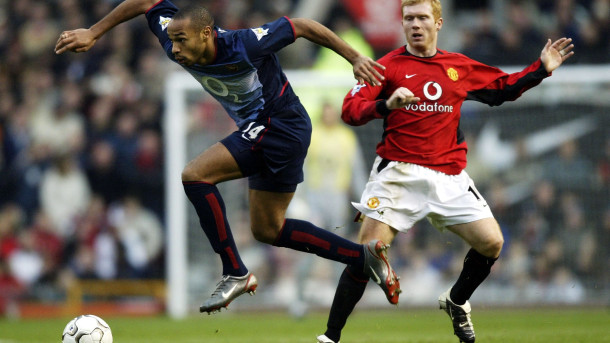
Ferguson was also focused on not conceding. Without Paul Scholes, Quinton Fortune joined Phil Neville and Roy Keane to create an equally powerful, intimidating midfield.
The two lineups reflected the mutual respect the teams had. Despite all the hatred and anger, both United and Arsenal understood the other team’s potency, and sought to neutralize it with defensive, negative lineups.
The game reflected both team’s plans. Early on it became clear that Arsenal was not going to play their distinctive possession, fluid passing style. Instead they ceded early possession to United, content to shadow them while not pressing too intensely.
Indeed it was clear that the impetus was clearly on United to create whatever offense would happen in the game. Increasingly United’s attacks were focused down the right side, resting particularly on the young Ronaldo. Matched up 1 v. 1 with Ashley Cole, Ronaldo was able to use his pace and dribbling skills to beat Cole on many occasions. Making inside cuts and outside runs, Ronaldo seemed to be the sole source of creativity in United’s side. Perhaps Beckham wasn’t missed after all.
The first 10 minutes were like the beginning of headline boxing match. The two boxers were testing each other, probing for weaknesses but not fighting aggressively enough to display any of their own. Play was cautious and cagey, lacking a certain edge both offensively and defensively.
It was nearly 15 minutes before the first chance of the game came. Ronaldo was fouled cutting inside from the right wing, giving United a free kick 40 yards from goal. Giggs stood over the ball, clearly looking to cross to one of United’s runners in the box. But his pass missed every player on both side, bounced by Lehmann and hit the post, going out for a goal kick. It was completely unintentional, but it had caught Lehmann off guard.
Just minutes later Ronaldo was brought down again, this time several yards in front of the corner flag. Giggs again stood over the free kick (a functional corner), whipping the ball hard across the face of goal. Lehmann backpedaled, caught in no man’s land. He tried to jump and get a hand to the ball, but missed, leaving the goal wide open. Van Nistelrooy, at the back post, now had an open header. Shaking Bergkamp off him, the Dutchman rose in the air and met the ball with his head. With an open net in front of him, Van Nistelrooy somehow missed, sending the ball onto the upper roofing of the goal. He was visibly angry with himself as play restarted, while Lehmann breathed a sigh of relief.
Lehmann was certainly looking shaky though. Whether it was the intensity of the match, or the pressure of filling the shoes of a great like Seaman (as Lehmann would do again in his international career, when Jurgen Klinnsmann replaced the great Oliver Kahn with Lehmann controversially), the two free kicks had exposed Lehmann’s angst. Later in the first half he would come off his line to collect a long ball, nearly running out of the box with the ball in his hands. The United players and crowd howled in rage at the ref, but he made the right decision not to punish Lehmann.
The rest of the first half continued in a similar pattern. United controlled the ball, focusing on the right side and Ronaldo. Arsenal would occasionally win the ball and look to counter quickly, as they did after 20 minutes. Ashley Cole picked the ball up on the halfway line and began to dribble. With no United player stepping up Cole continued to run. Finally he arrived at the edge of the box. Still not closed down, he popped a shot. It rolled just wide of Howard’s post.
The game grew more and more physical as the half wore on. Increasingly the ball was in the center of the park, where both teams had placed midfield dominators like Vieira and Gilberto, Keane and Neville. As game grew more physical, it also grew more tense, each side growing angrier.
After the break Arsenal looked more comfortable and outgoing. In the first half whatever little possession they had was usually stale, on purpose; they weren’t looking to attack, but to neutralize the match, and it worked; defensive possession at its best.
In the second half, however, Arsenal began to play more like themselves. They looked to combine through midfield more often, playing several passing sequences that were trademark Arsenal. More important Wenger’s side looked more aggressive, seeking out chances, rather than taking the ones that came to them. United responded to Arsenal’s aggressiveness in kind, turning up their defensive pressure. The game became more open and interesting, as both teams went on the hunt. Still though there were few chances. Indeed, Arsenal’s only chance came in the 75th minute, when Vieira was played through on goal by Bergkamp. Otherwise, though, both teams seemed happy to battle in midfield and keep the ball away from each other’s goals.
Two minutes after Vieira created that chance, he stuck a late leg at the ball as Fortune dribbled by. The United player tumbled over and Vieira was duly given a caution. He was unhappy nonetheless, but the referee had been dishing out cards all game and was completely justified in doing so. Then, several minutes later and just 10 minutes from the end, Vieira attempted to clear the ball from Arsenal’s half. His pass went straight to Phil Neville, who hit it back towards Arsenal’s goal. The ball floated off his foot, and drifted back to Vieira. As he positioned himself under the ball to collect it, Van Nistelrooy ran up to challenge for the ball. Seeing the Dutch striker coming, Vieira turned his back, bending over to avoid injury. As the ball sailed over, Van Nistelrooy went on top of Vieira’s back. Instead of just rolling off, though, Van Nistelrooy stuck a leg out, almost kicking Vieira to the ground. He immediately stared down at Vieira, arms out; perhaps to apologize, perhaps to taunt. Vieira in any case took exception to Van Nistelrooy’s challenge and response, swinging a leg at him.
Vieira’s kick was nowhere near Van Nistelrooy and wasn’t even violent, but the Dutchman made the most of it
Vieira’s kick was nowhere near Van Nistelrooy and wasn’t even violent, but the Dutchman made the most of it. He drew himself back, feigning (or maybe not feigning) astonishment. Vieira meanwhile was complaining to the referee about the striker’s challenge and play acting, not expecting any punishment himself. Then the ref reached into his pocket, pulling out both a yellow and a red. Evidently the only Arsenal player who understood what Steve Bennett was doing was Jens Lehmann, who sprinted out of goal to protest. Vieira was initially in shock, arguing with the ref. But then it dawned on him: Van Nistelrooy had gotten him sent off.
Vieira sprinted over, knocking Van Nistelrooy in the back. Soon all 21 players were in a bunch, most trying to separate Vieira and Van Nistelrooy. But Lehmann persisted after Van Nistelrooy, angrily jamming a finger in his face as he shouted accusations at the striker.
It took several minutes before Vieira was cleared off the field. Wenger, not trying to risk a loss, took off the hobbling Bergkamp (he had picked up a minor knock several minutes earlier) for midfielder Edu.
The last minutes were tense, with Arsenal incensed and United smelling blood. Still no chances came, even with United in full attack mode. This time, unlike the Highbury game from the last season, United wasn’t content with a draw; they wanted all three points.
Finally, in the last minute of stoppage time, Diego Forlan, who had replaced John O’Shea, made a diagonal run cutting through Arsenal’s box. Gary Neville sent a cross curling into the box. Forlan had a step on Keown, who was marking him, and was sure to get a head on the ball. But then suddenly Forlan tumbled over, missing the ball. He threw his arms up in protest, claiming Martin Keown had impeded him. The ref took a moment and then blew his whistle, signaling for a penalty.
Then Van Nistelrooy stepped up to the penalty spot.
It took several minutes to clear the penalty area, but even as the outfield players filtered out to the edges of the box, Lehmann continued to stand in Van Nistelrooy’s face. The German was trying to distract his opponent, break his focus from goal in any way possible. Even when Lehmann was forced onto the goal line by the official he didn’t stop. Lehmann ran back and forth on his line, waving his arms to catch the striker’s attention.
But Van Nistelrooy didn’t seem to notice. His eyes were fixed straight ahead, on the center of the goal. He had the intensity of a great goal scorer, obsessed with finishing the task. Finally the referee blew his whistle.
Van Nistelrooy wiped the sweat off his face one last time, and then began his run up. It was short and powerful. By the time his leg met the ball, Van Nistelrooy was nearly running. He put all the power his body had built up into the shot, sending the ball rocketing off his foot. Lehmann dove the wrong way, right, and watched helplessly as the ball sailed towards the open goal.
But the ball kept sailing, higher and higher. It hit the crossbar, bouncing all the way out of the penalty area. Van Nistelrooy had missed his chance.
United regained the rebound and tried to throw the ball back into the box for one last chance, but the ref blew the final whistle seconds later. Then ugliness started.
Van Nistelrooy… a cheat, and a habitual one at that
Van Nistelrooy was surrounded by five Arsenal players: Keown, Cole, Toure, Parlour and Lauren. Keown leapt in the air at the final whistle and while he was calm, the same couldn’t be said of his teammates. Gary Neville, Rio Ferdinand, Ronaldo, Quinton Fortune and Mikael Silvestre all rushed over, defending Van Nistelrooy. The standoff lasted a few seconds before the more level headed players on the field broke it up. But the battle continued off the field. Both Wenger and Vieira accused Van Nistelrooy of acting, selling the ref on Vieira’s second yellow card, in their post match interviews. “He is a great player,” said Wenger, “but his attitude… he is always looking to dive. He looks like a nice boy but on the pitch it is not always nice behavior.” Vieira echoed Wenger’s sentiment, saying “The ref got it wrong because of the reaction of Van Nistelrooy.” They called him a cheat, and a habitual one at that.
The match clearly represented all what football should not be: controversy, fighting and ill spirit. The FA saw this, and came down hard although, once again, the unfairness in their judgment remained. Six Arsenal players (Lauren, Keown, Parlour, Cole, Vieira and Lehmann) and two United players were charged with improper conduct, as well as Arsenal itself. Lehmann was eventually cleared of all charges, but the others didn’t escape so easily.
Vieira and Parlour were banned for one match, Keown three and Lauren four. All, including Cole who was not banned, had to pay fines ranging from £10,000-£20,000. Arsenal itself was fined £175,000, a record fee for a club.
The two United players, Ronaldo and Giggs, charged pleaded not guilty, and after several months of dispute were awarded £4,000 and £7,500 fines respectively and warned.
It was a dark moment for English football in general, out from the hooliganism of the late 80s and 90s. It was a dark moment for the rivalry, which had always toed the line between heated and violent. It was a dark moment for Arsenal, not least because it confirmed notions about their hot headedness and knack for melting down in tough moments . It was a dark moment for United, who where the masterminds of this negative atmosphere. It was a dark moment for everyone involved.
Without Vieira (after the three game ban he was in and out of the side for several months), and still rattled by the controversy, Arsenal struggled to separate from Chelsea and United. The lead shifted between the three for the remainder of the (calendar) year. United, sitting in third after a loss at Chelsea to end November, won all five of their games in December and their first in January to catapult into first.
Arsenal, with its full lineup back together for the first time since before the Battle of Old Trafford, finally clicked in early January. They won their next nine games, from mid January to the end of March. Meanwhile United won just three of nine, losing to City, Wolverhampton and Middlesbrough.
The season was over at that point, with Arsenal cruising to the finish line
The Gunners went from second place, down three points to United, to leading the league at the end of March, up nine on second place Chelsea and 12 on third place United. The season was over at that point, with Arsenal cruising to the finish line. Chelsea managed to win five in a row, but Arsenal had a game in hand the whole time, meaning the Blues were never really in reach.
Arsenal clinched the title in late April, with four games left. A 2-2 draw at Tottenham was all they needed to lengthen the gap over Chelsea to the insurmountable, and for the second time they had clinched the league at the rival’s ground (1971 was the first).
Arsenal ended the season with a 2-1 victory at Highbury over Leicester, finishing 11 points above Chelsea and 15 points above United. They became the first team since that 1888-89 Preston side to go an entire season unbeaten, earning the title “the Invincibles.”
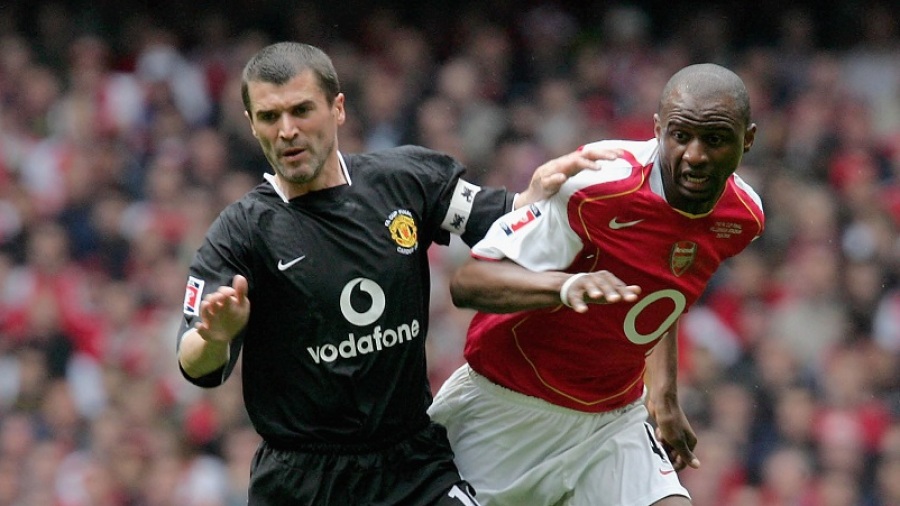
It was Wenger’s crowning achievement and the high water mark of his era. Arsenal went ten years after the 03-04 season without a trophy, before back to back FA Cup wins in 2014 and 2015 eased Wenger’s blushes.
The second United-Arsenal game, at Highbury in February, passed without incident, a plain 1-1 draw. But the next season at Old Trafford there was another classic Arsenal-United match and United were at their antics again.
Rooney was looking for an excuse to fall
Rooney won a penalty off a Sol Campbell tackle, but it was clear that Campbell was drawing out of the challenge and that Rooney was looking for an excuse to fall. Mike Riley unfairly awarded the penalty and Van Nistelrooy scored to give United the lead.
This time nothing happened on the pitch, but in the player’s tunnel there was a fight. Henry had to be held back by teammates after attacking Ferdinand, angry that the United captain had been awarded the Man of the Match (is that the only time anyone has actually cared about MOTM). Wenger then came over and began to yell at Van Nistelrooy, upset over a challenge the striker had made on Cole earlier (and surely other things). Ferguson responded by telling Wenger to leave his players alone, and soon the two managers were facing down. Then a piece of pizza hit Ferguson in the face, allegedly thrown by Cesc Fabregas. Finally police officers and stadium officials separated the teams, but it was once again an ugly look for English football and the rivalry.
With Jose Mourinho, Wenger’s eternal enemy and biggest thorn, now the manager of United, we could see a resurgence of the rivalry. Arsenal has featured in the title race more prominently in the last two seasons than it had for years before, the end of their trophy drought means demons have been exorcised.
Both United and Mourinho in the meantime have been wandering the Elysian Fields, caught in mid table between the title challengers and the bottom feeders.
As both teams improve and look to challenge once again for the title, it is worth remembering how fantastic and captivating their rivalry was. It was, and could be again, the Premier League’s greatest rivalry.
Amen !


